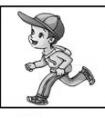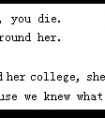What are they doing for holiday?They are happy because they are on holiday.Mary is visiting her aunt in Paris. She is very excited to be in Paris. It is a ve-八年级英语
题文
| What are they doing for holiday? They are happy because they are on holiday. Mary is visiting her aunt in Paris. She is very excited to be in Paris. It is a very famous city. And it is a good place to go shopping! Tom is fishing in the lake. Because the water is very clean, there are so many fish in the lake. Tom is having a good harvest (收获). Simon and Bill are good friends. They are usually very busy with their study every day. So they want to do something different. They are going bike riding together in the beautiful countryside (农村,乡下). It’s relaxing. Jesse is taking some photos in the park. The park is very beautiful in autumn, and it’s a good place to take photos. Everyone gets tired sometimes. It’s important to have a rest. And it’s good for your health. It can help you work or study better, too. I hope everyone is having a good time.
| ||||||||||||||||||
答案
小题1:holiday 小题2:Visiting her aunt 小题3:Tom 小题4:Going bike riding 小题5:In the park |
| 先阅读文章,再根据上下文,选择适当的单词的适当形式,注意题目的要求。 |
据专家权威分析,试题“What are they doing for holiday?They are happy because they..”主要考查你对 连词成句 等考点的理解。关于这些考点的“档案”如下:
连词成句
考点名称:连词成句
- 连词成句:
即是把错乱排列的词语根据语法或句法特点排列组合成为句式整齐,内容恰当,语气流畅的句子的方法。
他基本的要求是句子完整和流畅没有语法错误,更不要有语病。 连词成句题做题技巧:
首先强调第一个单词的第一个字母要大写,其次句子的最后要有标点符号。然后分句型来做:
1. 陈述句的时候,先找主语,然后找动词,再找其他,记得时间和地点是放在后面的。
2. 疑问句时,有疑问词的情况下找疑问词,然后找助动词,找主语,找其他。没有疑问词的情况下,就找助动词/be动词,再找主语,找其他。
3. 做这一类型的题目时,学生要有一定的基础,会认读单词,熟悉基本句型。
具体可以分一下几步来完成:
一、看清标点符号
1.如果是句号,则是陈述语句。陈述句的基本结构就是主语+谓语+宾语而构成的。
2.如果是问号,则是疑问语句。要先看是特殊疑问句还是由情态动词引导的疑问句。
①如果有where 、what、how等疑问词,那么它就是特殊疑问句,就要把疑问词where 、 what、 how 等放在一句话的最前面,它后面紧接的是be动词也就是我们学习过的am、is、are三个单词。
②如果题目中有can、 may、shall、would等情态动词,那么它就是由情态动词引导的疑问句。
例如:“have I a may new bike (?)” 。这道题目中有一个情态动词may,很显然这就是由情态动词may引导的疑问句。那么我们就要把may放在句子的最前面,后面紧接的就是这句话的主语(主语往往是人或者物)。
很快我们就能写出这句话的前半部分“May I have …”很显然,还剩下的几个单词可以构成一个词组“a new bike”,那么将整句话连起来就是“May I have a new bike ?”(我可以拥有一个新的自行车吗?)。
同样其他的句子,例如:由can 、would、shall等情态动词引导的句子也是这样的方法可以完成。
③如果题目中没有任何的特殊疑问词,也没有任何情态动词,那么它就是我们最最熟悉的一般疑问句了。
例如:“you a are student(?)”。很显然是一个疑问句,而且没有任何特殊疑问词。所以这是一句一般疑问句,一般疑问句的基本准则就是疑问词是be动词(am /is/are),而且要把它们放在句子的最前面。
- 最新内容
- 相关内容
- 网友推荐
- 图文推荐
| [家长教育] 孩子为什么会和父母感情疏离? (2019-07-14) |
| [教师分享] 给远方姐姐的一封信 (2018-11-07) |
| [教师分享] 伸缩门 (2018-11-07) |
| [教师分享] 回家乡 (2018-11-07) |
| [教师分享] 是风味也是人间 (2018-11-07) |
| [教师分享] 一句格言的启示 (2018-11-07) |
| [教师分享] 无规矩不成方圆 (2018-11-07) |
| [教师分享] 第十届全国教育名家论坛有感(二) (2018-11-07) |
| [教师分享] 贪玩的小狗 (2018-11-07) |
| [教师分享] 未命名文章 (2018-11-07) |






